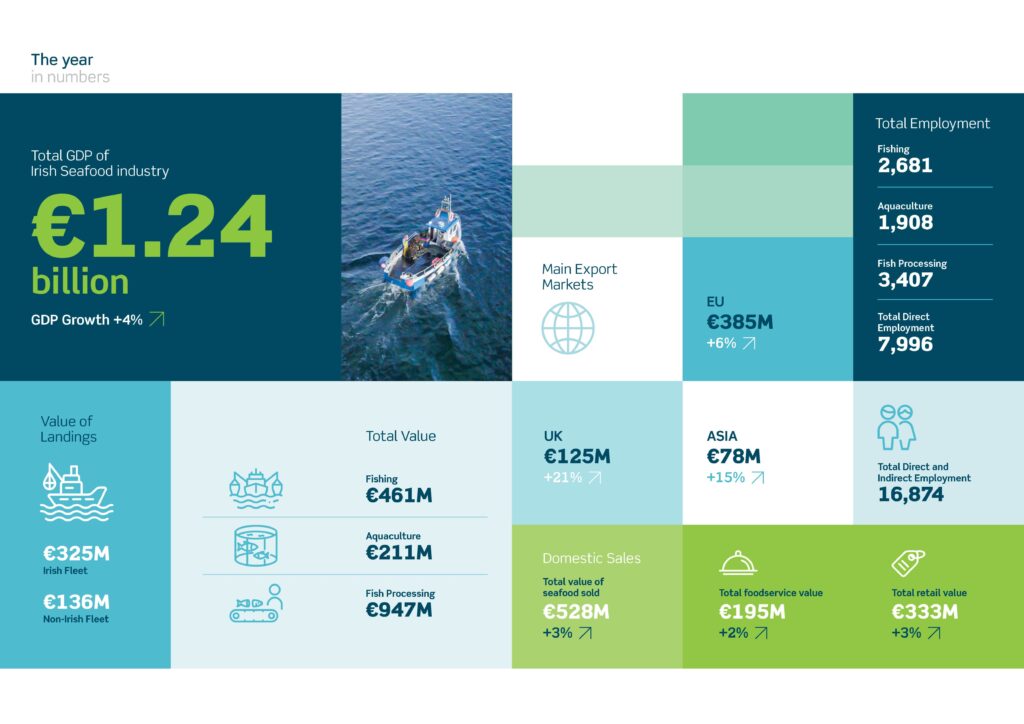
€1.24bn
GDP of Irish Seafood
16,874
Working in Seafood
€461m
Value of Fishing
€211m
Value of Aquaculture
€957m
Value of Fish Processing

Levels of investment in 2024 signalled continued confidence in the sector at €422.6 million. Private investment increased to €190 million (+12%). Government investment was €23.2 million, a slight decline (-12%) compared to 2023. Ireland’s seafood sector in 2024 demonstrated resilience by navigating a challenging year shaped by external pressures and long-term structural change. Behind the 4% increase in GDP from 2023, bringing the sector’s value to €1.24 billion, lies a story of industry adaptation in the face of constrained quotas, changing market dynamics, and growing spatial pressures at sea.
At the heart of Ireland’s fishing sector is a heavy reliance on two core species: mackerel and Nephrops. In 2024, these species accounted for a combined total of €158 million, just under half of the value of all Irish landings, underlining the sector’s vulnerability to quota shifts and market disruption to these species. While mackerel prices reached record highs, a 16% quota cut limited sustainable gains for many vessels. Nephrops, meanwhile, remained a stable source of income thanks to strong demand in European markets, but their importance also reveals the narrow base on which much of the demersal fishing sector now depends.
Aquaculture, by contrast, recorded strong growth with a 25% increase in value driven largely by the rebound of salmon production. After a poor harvest in 2023, output for salmon increased by 51%, lifting the overall tonnage output of the sector. However, this masks challenges elsewhere: rope mussel and oyster producers struggled with poor seed settlement, weak export markets, and high mortalities both demonstrating decreased
production levels. Salmon remains the primary driver of profitability for Irish aquaculture and continues to shape the overall performance of the sector year on year.
The processing sector demonstrated a modest 3% drop in 2023 the latest year available for the sector. However, backed by over €37 million in support through the EU funded Brexit Adjustment Reserve (BAR) funding, the sector is now undergoing a major capital reinvestment. This includes upgrades in energy efficiency, automation, and product innovation, helping processors prepare for tighter supply chains and greater export competition. This wave of investment will reshape how and where value is added in the seafood supply chain. Trade performance offered a clear signal of market strength. Exports rose by 9%, and the trade balance improved by €50 million, making a strong contribution to overall GDP. Imports rose sharply in volume (25%), driven by falling prices for species such as salmon, prawns, and tuna, a sign that processors and consumers are increasingly price sensitive and seeking flexibility. This highlights the need for Ireland’s seafood products to remain both premium and competitive in a global market.
Levels of investment in 2024 signalled continued confidence in the sector at €423 million. Private investment increased to €190 million (+12%) while Ireland’s Seafood Development Programme, cofunded by the EU and the Government of Ireland investment stood at €233 million.
Looking ahead, 2025 is set to be another year of transition and adjustment. Demersal quotas in the northwest have improved, offering some regional uplift but other demersal stocks in the east and south have experiences reductions. While horse mackerel quota has risen again, some key pelagic stocks face cuts, and spatial pressures from offshore wind development, marine protected areas, and other marine users are intensifying. Reports from ICES and EU policymakers make clear that the squeeze on sea space is no longer a future concern – it’s a current reality. In parallel, the Irish seafood industry continues to face several challenges including labour shortages, rising operational costs, and continuing Brexit legacy issues. However, there is also cause for confidence including a strong export base, rising investment in processing opening innovation opportunities, and hopefully positive impacts for the demersal sector following from the voluntary permanent decommissioning scheme. BIM’s role is to guide and support the sector through this transition. Our focus is on helping businesses build resilience whether through selective gear trials, aquatech innovation, and capital investment support. The sector may be under pressure, but it is also strategically vital to Ireland’s coastal
communities and food system. With the right support, it can remain a dynamic and sustainable contributor to Ireland’s blue economy.